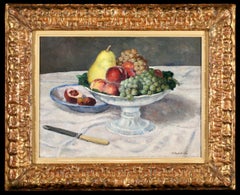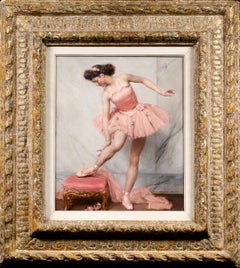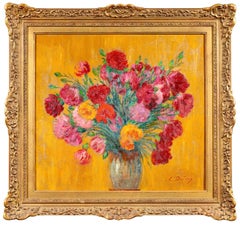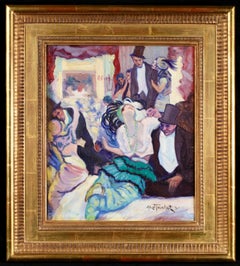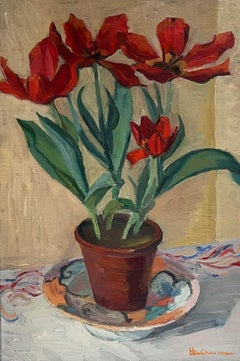Leighton Fine Art Ltd Interior Paintings
to
1
2
10
6
Overall Width
to
Overall Height
to
5
14
2
5
3
1
1
9
8
1
11
8
10
10
3
3
2
1
1
1
1
1
1
1
1
1
1
1
1
1
1
19
19
15
15
2
3
2
2
1
1
19
19
Le Dessert - Post Impressionist Still Life Oil Painting by Albert Andre
By Albert Andre
Located in Marlow, Buckinghamshire
Signed and titled still life oil on canvas circa 1898 by French post impressionist painter Albert André. The work depicts a still life scene in an interior. A glass bowl filled with ...
Category
1890s Post-Impressionist Still-life Paintings
Materials
Canvas, Oil
Arrangement Japonais - Post Impressionist Still Life by Jacques Martin-Ferrieres
By Jacques Martin-Ferrières
Located in Marlow, Buckinghamshire
Signed still life oil on panel by French post impressionist painter Jacques Martin-Ferrieres. The work depicts an ornate cream ceramic vase with gold trim beside a blue vase filled w...
Category
1940s Post-Impressionist Still-life Paintings
Materials
Oil, Panel
Nature Morte - Post Impressionist Still Life Oil Painting by Georges D'Espagnat
By Georges d'Espagnat
Located in Marlow, Buckinghamshire
Signed oil on canvas still life circa 1910 by French post impressionist painter Georges D'Espagnat. The work depicts three ceramic vases of flowers on a table. There is a tale green ...
Category
1910s Post-Impressionist Still-life Paintings
Materials
Canvas, Oil
Une Ballerine - Realist Figurative Oil Painting by Auguste Leroux
Located in Marlow, Buckinghamshire
Signed oil on canvas figure in interior circa 1930 by French realist painter Jules Marie Auguste Leroux. The work depicts a brunette ballerina wearing a pink tutu and pointe shoes st...
Category
1930s Realist Figurative Paintings
Materials
Canvas, Oil
Vase de fleurs - Impressionist Still Life Oil Painting by Leon Detroy
By Leon Detroy
Located in Marlow, Buckinghamshire
Signed still life oil on canvas circa 1920 by French impressionist painter Leon Detroy. The work depicts a ceramic vase filled with flowers in reds, pinks and yellows and set agains...
Category
1920s Impressionist Still-life Paintings
Materials
Canvas, Oil
Le Cabaret - Montmartre 1897- Impressionist Figurative Oil by Louis Abel Truchet
By Louis Abel-Truchet
Located in Marlow, Buckinghamshire
Signed and dated oil on canvas figures in interior by French impressionist painter Louis Abel Truchet. The piece depicts revellers at a French cabaret Montmartre.
Signature:
Signed ...
Category
1890s Impressionist Figurative Paintings
Materials
Canvas, Oil
Le Bal de Moulin Rouge - Modernist Figurative Oil by Marcel Francois Leprin
By Marcel François Leprin
Located in Marlow, Buckinghamshire
Signed, titled and dated 1921 figures in interior oil on canvas by Modernist painter Marcel Francois Leprin. This wonderful piece depicts a ball at the Moulin Rouge, a cabaret in Par...
Category
1920s Modern Figurative Paintings
Materials
Canvas, Oil
Arrangement de fleurs - Impressionist Still Life Painting Oil by Leon Detroy
By Leon Detroy
Located in Marlow, Buckinghamshire
Signed still life oil on canvas circa 1930 by French impressionist painter Leon Detroy. The work depicts a vase filled with roses and peonies in deep reds and pinks.
Signature:
Sign...
Category
1930s Impressionist Still-life Paintings
Materials
Canvas, Oil
Fleurs sur une table - Post Impressionist Still Life by Jacques Martin-Ferrieres
By Jacques Martin-Ferrières
Located in Marlow, Buckinghamshire
Signed still life oil on canvas circa 1910 by French post impressionist painter Jacques Martin-Ferrieres. The work depicts a black ceramic jar with w...
Category
1910s Post-Impressionist Still-life Paintings
Materials
Canvas, Oil
Nature morte aux pommes - Post Impressionist Still Life Oil -Hippolyte Petitjean
By Hippolyte Petitjean
Located in Marlow, Buckinghamshire
Signed still life oil on canvas circa 1920 by French post impressionist painter Hippolyte Petitjean. depicting a beautifully coloured view of a vast landscape. The piece depicts a green jug, a bowl of red apples, a brown two-handled jug and a vase of flowers, all placed on a wooden table. Several landscape paintings adorn the wall behind.
Signature:
Signed with cachet lower right and again verso
Dimensions:
Framed: 26"x30"
Unframed: 18"x22"
Provenance:
Galerie de l'Institut - Centenary Exhibition of Hippolyte Petitjean (1955 ) - original labels verso
Hippolyte Petitjean started his training in Mâcon and then became a student at the École des Beaux-Arts, Paris, where he worked in Cabanel's studio. By selling two Seurat paintings...
Category
1920s Post-Impressionist Still-life Paintings
Materials
Canvas, Oil
Interieur - Effet de Lampe - Impressionist Interior Oil by Edouard Cortes
By Édouard Leon Cortès
Located in Marlow, Buckinghamshire
Signed figures in interior oil on canvas circa 1920 by sought after French impressionist painter Edouard Leon Cortes. This charming and nostalgic work depicts a family in a typical Breton kitchen scene. An elderly lady is seated at the table with her back to the artist and a young girl also sits at the table beside a bowl of oranges and a carafe of red wine. Another lady stands at the table under the light of the lamp.
Signature:
Signed lower right
Dimensions:
Framed: 29.5"x34"
Unframed: 21.5"x26"
Provenance:
Salon des Independants - 1922 exhibition
Galleries Maurice Sternberg - Chicago
Original artists label with title and number "9" on the reverse.
Edouard Leon Cortes, the son of the painter Antonio Cortès, was sent to the front during World War I to sketch enemy positions. In civilian life, his base was in Lagny in the former studio of Cavallo-Peduzzi. Although he travelled extensively in France. Notably in Normandy, Brittany, the Champagne region and Savoy painting...
Category
1920s Impressionist Figurative Paintings
Materials
Canvas, Oil
Les Baigneuses - Impressionist Figurative Landscape Oil by Jean Louis Forain
By Jean Louis Forain
Located in Marlow, Buckinghamshire
Signed impressionist figurative oil on canvas circa 1890 by sought after French impressionist painter Jean Louis Forain. The piece depicts bathers in a dark landscape.
Signature:
Signed lower right
Dimensions:
Framed: 32"x37"
Unframed: 24"x29"
Provenance:
Private French collection
Jean Forain was the son of a painter and decorator and was apprenticed to a visiting card engraver. He studied briefly under Gérôme and Carpeaux at the École des Beaux-Arts in Paris and regularly visited the Louvre, where he copied works by the masters. It is said that for a time he made a precarious living by selling small drawings in the style of Grévin. He went on to collaborate on various publications as a draughtsman and columnist, starting in 1876 on La Cravache and then collaborating on the newspapers Le Journal Amusant, Le Figaro and L'Écho de Paris. This introduced him to the diverse worlds of Paris society - the world of the theatre, of shows, and of literature - where he wryly noted the habits and shortcomings particular to each. This led him to follow a route very characteristic of this period, already seen in the work of Steinlen, Caran d'Ache and Toulouse-Lautrec in the journals La Pléiade, La Vogue...
Category
1890s Impressionist Figurative Paintings
Materials
Canvas, Oil
The Piano Recital - Impressionist Figurative Interior Oil by Frederick Frieseke
By Frederick Carl Frieseke
Located in Marlow, Buckinghamshire
Signed and dated oil on canvas figure in interior painting by American impressionist painter Frederick Carl Frieseke. The piece depicts a young girl in a pink dress seated at a piano...
Category
1920s American Impressionist Figurative Paintings
Materials
Oil, Canvas
Interieur a la fenetre ouverte - Post Impressionist Oil by Edouard Vuillard
By Edouard Vuillard
Located in Marlow, Buckinghamshire
Signed oil on board interior by French Les Nabis painter Edouard Vuillard. The work depicts a room with a large window, outside of which are bare trees. Inside the room are three chairs and a patterned rug on the floor.
Signature:
Signed lower left
Dimensions:
Framed: 20"x13"
Unframed: 13"x6"
Provenance:
Prince Antoine Bibesco (1878-1951) - Special Envoy of Romania to the United States
Piasa Encheres - Paris Lot no. 88 - 8th April 2005 - Sold EUR 118,000 hammer price
Acquired at the above by Thomas Gibson Fine Art - London
Acquired by the previous owner from Thomas Gibson Fine Art - TEFAF Maastricht November 2005
Literature:
This work is included in the catalogue rasionne of the work of Edouard Vuillard under Ref Volume II No. 172 - illustrated and described
Access to the raisonne online can be found at the Wildenstein Plattner Institute website.
The work is described as being executed in the period 1899 to 1904 by Antoine Salomon and Guy Cogeval
Édouard Vuillard attended the Lycée Condorcet in Paris, where he made friends with Maurice Denis, Lugné-Poe, and Ker-Xavier Roussel, later his brother-in-law. He studied in Maillart’s studio; for six weeks came under the tutelage of Jean-Léon Gérôme at the École des Beaux-Arts in Paris; and later under William Bouguereau and Robert at the Académie Julian, where he became closely linked with the Nabis group (from the Hebrew word for ‘prophet’). He met Marcel Proust in 1902. From 1908, he taught at the Académie Ranson. In 1937, he was elected member of the Institute.
At first, Édouard Vuillard painted small subjects, disciplined and proficient, qualities for which the prestigious École Française was famous. His earliest still-lifes (1888) are astonishing in their decisiveness and subtlety. His empathy for the object had already compelled him to soften its appearance; the object, which, by virtue of its bright or glossy presence, remained the nonego and the ‘thing represented’ for so many others. ‘Intimacy’ developed immediately between the painter and this modest environment; inhabiting it every day enabled him to celebrate its splendour, and it was to remain his favourite environment. But he was already alternating between small portraits and still-lifes, which gained recognition because of their natural qualities and dignity of tone: a rare combination in a beginner.
About 1890, influenced indirectly by Paul Gauguin, all the certainties which the self-styled Nabis painters had contented themselves with suddenly collapsed. Everything was called into question again: both the linear layout of the picture and its colour scheme; the choice of subject and its material aspect; its manufacture and its purpose. Vuillard’s paintings at that time show surprising, bold innovations and an arbitrary power, which one would expect 15 or 20 years later at the height of the Fauvist period. The preoccupation with an internal geometry set them apart from earlier studies. From then on, the paintings were based on forms, lines, and colours. Vuillard made concessions. He produced a portrait or interior with its furniture and its wallpapers, in which the family inhabiting it, evolves. Treated with flat areas of colour and solid shades of ochres, reds, blues, and saffron yellow, without modulation, they seem to prefigure certain paintings by Henri Matisse and Roger de La Fresnaye.
In 1891, Édouard Vuillard painted an Elegant Lady, a silhouette seen from the back; a long vertical shape starting from the hair decorated with brown feathers; there is a kind of pink cloak, the tight and never-ending black skirt, erect in front of a half-open, bright orange door in a green wall, from where the light of another vertical shape emerges, which is bright yellow, and is reflected in red on the parquet at the feet of the elegant lady. This painting meets his concerns about the actual moment of creating ‘harmonies corresponding to our feeling’, and by virtue of its almost geometric structure, its drawing entirely free of detail, its light effects and colour harmonies, very much prefigures aspects of the future Abstraction movement and is oddly reminiscent of the final period of Nicolas de Staël.
All too often, Édouard Vuillard is only admired in his role as the harmonist, the serene contemplator who combines an exquisite sense of nuance, rhythms, and values with the most acute observation. These singular investigations, these three-dimensional meditations including a table, a folding metal cot...
Category
1890s Post-Impressionist Interior Paintings
Materials
Oil, Board
Nature morte aux fruits - Post Impressionist Still Life Oil by Henri Lebasque
By Henri Lebasque
Located in Marlow, Buckinghamshire
Signed oil on board still life circa 1937 by French post impressionist painter Henri Lebasque. The work depicts a basket of fruit filled with apples, grapes and oranges.
Signature:
Signed lower left
Dimensions:
Framed: 33"x36"
Unframed: 26"x29"
Provenance:
This work is included in Tome 1 of Mme. Denise Bazetoux's Catalogue Raisonne of the works of Henri Lebasque - No.895.
Madame Lenoble (by 1957)
Christie's, London, 29 November 1995, lot 191
The collection of Ann & Gordon Getty (purchased at the above sale by the Gettys)
Exhibition History:
Paris, Palais Galliéra, "Célébrités et révélations de la peinture...
Category
1930s Post-Impressionist Still-life Paintings
Materials
Oil, Board
Le Piano - Post Impressionist Figurative Interior Painting by Emilio Grau Sala
By Emilio Grau Sala
Located in Marlow, Buckinghamshire
Signed and titled oil on canvas figure in interior circa 1950 by Spanish post impressionist Emilio Grau Sala. The work depicts a red-haired lady in a red dress seated at a piano. A y...
Category
1950s Post-Impressionist Figurative Paintings
Materials
Oil, Canvas
Early Evening - Brittany - Impressionist Interior Oil Painting by Edouard Cortes
By Édouard Leon Cortès
Located in Marlow, Buckinghamshire
Signed figures in interior oil on canvas circa 1925 by sought after French impressionist painter Edouard Leon Cortes. This charming and nostalgic work depicts a family in a typical Breton kitchen scene. A lady is seated at the table while another slices a loaf of bread for a young girl. The view from the large window shows cottages in the distance and the last light of the day on the horizon as night falls. The light of an overhead oil burner illuminates the room.
Signature:
Signed lower left
Dimensions:
Framed: 30"x25"
Unframed: 26"x21"
Provenance:
This work has been examined and authenticated by Mme. Nicole Verdier and will appear in Tome IV of the catalogue raisonne. An accompanying certificate from Mme. Verdier is available upon request at a charge of 960 EUR.
Private French collection
Edouard Leon Cortes, the son of the painter Antonio Cortès, was sent to the front during World War I to sketch enemy positions. In civilian life, his base was in Lagny in the former studio of Cavallo-Peduzzi. Although he travelled extensively in France. Notably in Normandy, Brittany, the Champagne region and Savoy...
Category
Early 20th Century Impressionist Figurative Paintings
Materials
Canvas, Oil
A Breton Interior - Impressionist Interior Oil Painting by Edouard Cortes
By Édouard Leon Cortès
Located in Marlow, Buckinghamshire
Signed figures in interior oil on canvas circa 1910 by sought after French impressionist painter Edouard Leon Cortes. This charming and nostalgic work depicts a family enjoying dinner in a typical Breton kitchen scene. A man and lady are seated at the table while a woman serves them from a steaming pot. The light of an overhead oil burner illuminates the room.
Signature:
Signed lower right
Dimensions:
Framed: 26"x23"
Unframed: 18"x15"
Provenance:
This work will be included in the supplement to Tome III of the Catalgue Raisonne of Edouard Cortes under preparation by Mme. Nicole Verdier
This work is accompanied by a photo certificate from Mme. Nicole Verdier under reference EC221203/HT/GEO-241
Edouard Leon Cortes, the son of the painter Antonio Cortès, was sent to the front during World War I to sketch enemy positions. In civilian life, his base was in Lagny in the former studio of Cavallo-Peduzzi. Although he travelled extensively in France. Notably in Normandy, Brittany, the Champagne region and Savoy painting...
Category
Early 20th Century Impressionist Interior Paintings
Materials
Canvas, Oil
Deux vieillards aux chatons - Impressionist Figurative Oil by J F Raffaelli
By Jean-Francois Raffaelli
Located in Marlow, Buckinghamshire
Signed figures in interior oil on panel by French impressionist painter Jean-Francois Raffaelli. The piece depicts two old men seated in an interior. One is reading his paper as the other naps and there are several kittens on the floor. Painted in the artist's distinctive style.
Signature:
Signed lower left
Dimensions:
Framed: 9.5"x8"
Unframed: 5.5"x4"
Provenance:
Brame & Lorenceau have confirmed the authenticity of this work and it will be included in the digital catalogue raisonne of the painter which is under preparation
A certificate of authenticity fromBrame & Lorenceau accompanies this painting
Private collection - United States
Original artists label verso
Jean-François Raffaëlli's father was a failed Italian businessman and Raffaëlli himself was, among other things, a church chorister, actor and theatre singer. He then studied under Gérôme at the École des Beaux-Arts in Paris. He travelled to Italy, Spain and Algeria and on his return to France settled in Asnières.
In 1876, on a trip to Brittany, he first saw the potential of realist subject matter, if treated seriously. He became involved in meetings of artists at the Café Guerbois, where the Impressionist painters used to gather. As a result, Degas, contrary to the advice of the group, introduced Raffaëlli to the Impressionist exhibitions - according to one uncertain source as early as the very first exhibition, at the home of Nadar, and certainly to those of 1880 and 1881.
In 1904, Raffaëlli founded the Society for Original Colour Engraving. He first exhibited at the Salon de Paris in 1870 and continued to exhibit there until he joined the Salon des Artistes Français in 1881, where he earned a commendation in 1885, was made Chevalier of the Légion d'Honneur in 1889 and in the same year was awarded a gold medal at the Exposition Universelle. In 1906 he was made Officier of the Légion d'Honneur. He was also a member of the Société Nationale des Beaux-Arts. In 1884, a private exhibition of his work cemented his reputation.
He contributed to several newspapers such as The Black Cat (Le Chat Noir) in 1885 and The French Mail (Le Courrier Français) in 1886 and 1887. He published a collection entitled Parisian Characters, which captured his favourite themes of the street, the neighbourhood and local people going about their lives. In 1880 he participated, with Forain, on the illustration of Joris Karl Huysmans' Parisian Sketches (Croquis Parisiens). He also illustrated Huysman's Works. As well as working as an illustrator, he also made etchings and coloured dry-points.
His early attempts at painting were genre scenes, but once he was settled in Asnières he started to paint picturesque views of Parisian suburbs. From 1879 onwards, his subject matter drew on the lives of local people. These popular themes, which he treated with humanity and a social conscience, brought him to the attention of the social realist writers of the time such as Émile Zola. In addition to his realist style, Raffaëlli's dark palette, which ran contrary to the Impressionist aesthethic, helped to explain the opposition of those painters to his participation in their exhibitions. More concerned with drawing than colour, he used black and white for most of his paintings. Towards the end of his life, he lightened his palette, but without adopting any other principles of the Impressionist technique.
After painting several portraits, including Edmond de Goncourt and Georges Clémenceau, he returned to genre painting, particularly scenes of bourgeois life. Later in his career, he painted mainly Breton-inspired sailors and views of Venice. His views of the Paris slums and the fortifications, sites which have almost completely disappeared, went some way towards establishing a genre in themselves and perpetuated the memory of the area: The Slums, Rag-and-Bone Man, Vagabond, Sandpit, In St-Denis, Area of Fortifications. His realistic and witty portrayal of typical Parisian townscapes accounts for his enduring appeal.
Born in Paris, he was of Tuscan descent through his paternal grandparents. He showed an interest in music and theatre before becoming a painter in 1870. One of his landscape paintings was accepted for exhibition at the Salon in that same year. In October 1871 he began three months of study under Jean-Léon Gérôme at the École des Beaux-Arts in Paris; he had no other formal training.
Raffaëlli produced primarily costume pictures until 1876, when he began to depict the people of his time—particularly peasants, workers, and ragpickers seen in the suburbs of Paris—in a realistic style. His new work was championed by influential critics such as J.-K. Huysmans, as well as by Edgar Degas.
The ragpicker became for Raffaëlli a symbol of the alienation of the individual in modern society. Art historian Barbara S. Fields has written of Raffaëlli's interest in the positivist philosophy of Hippolyte-Adolphe Taine, which led him to articulate a theory of realism that he christened caractérisme. He hoped to set himself apart from those unthinking, so-called realist artists whose art provided the viewer with only a literal depiction of nature. His careful observation of man in his milieu paralleled the anti-aesthetic, anti-romantic approach of the literary Naturalists, such as Zola and Huysmans.
Degas invited Raffaëlli to participate in the Impressionist exhibitions of 1880 and 1881, an action that bitterly divided the group; not only was Raffaëlli not an Impressionist, but he threatened to dominate the 1880 exhibition with his outsized display of 37 works. Monet, resentful of Degas's insistence on expanding the Impressionist exhibitions by including several realists, chose not to exhibit, complaining, "The little chapel has become a commonplace school which opens its doors to the first dauber to come along."An example of Raffaëlli's work from this period is Les buveurs d'absinthe (1881, in the California Palace of Legion of Honor Art Museum in San Francisco). Originally titled Les déclassés, the painting was widely praised at the 1881 exhibit.
After winning the Légion d'honneur in 1889, Raffaëlli shifted his attention from the suburbs of Paris to city itself, and the street scenes that resulted were well received by the public and the critics. He made a number of sculptures, but these are known today only through photographs.[2] His work was also part of the painting event in the art competition at the 1912 Summer Olympics. In the later years of his life, he concentrated on color printmaking. Raffaëlli died in Paris on February 11, 1924
Museum and Gallery Holdings:
Béziers: Peasants Going to Town
Bordeaux: Bohemians at a Café
Boston: Notre-Dame; Return from the Market
Brussels: Chevet of Notre-Dame; pastel
Bucharest (Muz. National de Arta al României): Market at Antibes; Pied-à-terre
Copenhagen: Fishermen on the Beach
Douai: Return from the Market; Blacksmiths
Liège: Absinthe Drinker...
Category
1890s Impressionist Figurative Paintings
Materials
Oil, Panel
Related Items
"The Barber of Seville", Early 20th Century Oil on Canvas by José Villegas
Located in Madrid, ES
JOSÉ VILLEGAS CORDERO
Spanish, 1844 - 1921
THE BARBER OF SEVILLE
signed & dated "J. Villegas. / Junio 1913." (lower left)
oil on canvas
19-3/8 x 28-3/4 inches (49 x 73 cm.)
framed: 27-1/2 x 36-3/4 inches (69.5 x 93 cm.)
PROVENANCE
Private Collector, Seville, Spain
José Villegas Cordero (Seville, August 26, 1844-Madrid, November 9, 1921) was a Spanish painter. He directed the Prado Museum between 1901 and 1918.
He was the brother of the painter Ricardo Villegas Cordero. He began his apprenticeship very young with José María Romero, with whom he remained for two years until entering the School of Fine Arts in Seville, where he was under the tutelage of Eduardo Cano.
In 1860, when he was only 16 years old, he sold his work Little Philosophy for 2,000 reais at the Seville Exhibition. In 1867 he traveled to Madrid, where he entered Federico Madrazo's studio. There he established friendship with painters Eduardo Rosales and Fortuny.
He went regularly to the Prado where he copied Velázquez, from whom he acquired spontaneity and the use of color for his technique.
Finally, and out of admiration for Fortuny's orientalist painting, he returned to Seville and organized an excursion to Morocco.
At the end of 1868 he decided to travel to Rome accompanied by the painters Rafael Peralta and Luis Jiménez Aranda...
Category
1910s Realist Figurative Paintings
Materials
Canvas, Oil
$9,449
H 19.3 in W 28.75 in
Mid 20th Century French Signed Oil Painting Red Tulips in Interior original frm
Located in Cirencester, Gloucestershire
Red Tulips in Interior
by Marcel Chesneau (French 1902 - 1975)
signed oil on canvas, framed
framed: 26 x 19 inches
canvas: 22 x 15 inches
provenance: private collection, France
condi...
Category
Mid-20th Century Post-Impressionist Still-life Paintings
Materials
Oil, Canvas
Old Times House Interior Scene with Naughty Boy 19th century Genre Oil Painting
Located in Stockholm, SE
The painting captures a wonderfully amusing family moment set in the 16th century. In the center of the painting we see the father, exhausted by worries and dozing in his chair in fr...
Category
Late 19th Century Realist Interior Paintings
Materials
Canvas, Wood, Oil
$350
H 24 in W 19.7 in D 1 in
"Lattice", Oil painting
Located in Denver, CO
Yana Beylinson's (US based) "Lattice" is an oil painting that depicts impressionistic mauve, pink, and white flowers in situ with a gold leaf lattice pattern on the lavender colored ...
Category
2010s American Impressionist Still-life Paintings
Materials
Gold Leaf
Kit Impressionism Reclining Figure in Chair Interior Oil on Canvas 14" x 14"
Located in Houston, TX
Look for Free Shipping at Checkout
Kit is an American Impressionist figurative painting by Stuart Fullerton. The artist is known for his landscape, still-life, portraits and citys...
Category
2010s American Impressionist Figurative Paintings
Materials
Oil, Canvas
$2,200
H 14 in W 14 in D 1.5 in
The Poor Girl – An Early Genre Scene by Julius Kronberg, 1873
Located in Stockholm, SE
This small, tenderly rendered painting— titled The Poor Girl (Den fattiga flickan)—offers a rare glimpse into Julius Kronberg’s early period, when he w...
Category
1870s Realist Figurative Paintings
Materials
Canvas, Oil
$3,771
H 12.21 in W 10.24 in
The Wool Winder (1877) by Swedish Female Artist Emma Ekwall
Located in Stockholm, SE
In The Wool Winder, Emma Ekwall captures a moment of quiet domestic intimacy between a young woman and a man as they wind wool together—she with focused care, he with gentle attentiv...
Category
1870s Realist Figurative Paintings
Materials
Canvas, Oil
$5,315
H 28.35 in W 24.81 in
Antique American Impressionist Flower Still Life Nicely Framed Oil Painting
Located in Buffalo, NY
Impressive early American impressionist flower still life oil painting. Framed. Oil on canvas. Signed. Image size, 30.5H by 21.5L.
Category
1920s Impressionist Interior Paintings
Materials
Canvas, Oil
$1,020 Sale Price
20% Off
H 37 in W 29 in D 2 in
Sea Food Platter Still Life Lobster & Sea Food on Table Signed French Oil Paint
Located in Cirencester, Gloucestershire
Artist/ School: French artist, circa 1950s, signed to the lower corner
Title: Sea Food Table (wine bottle, lobster, oysters, etc)
Medium: oil painting on ca...
Category
Mid-20th Century Impressionist Interior Paintings
Materials
Oil, Canvas
$1,758
H 27.25 in W 31.5 in D 3 in
Superb French Post-Impressionist Signed Oil Still Life Fruit & Champagne
Located in Cirencester, Gloucestershire
Artist/ School: signed Guy Benard (French, contemporary)
Title: 'Nature Morte'
Medium: oil on canvas, unframed and inscribed verso
Canvas: 18 x 21.5 inch...
Category
21st Century and Contemporary Post-Impressionist Still-life Paintings
Materials
Oil
$1,629
H 18 in W 21.5 in
"Golden Roses" Original Oil on wood Panel 17th Annual Carmel Art Festival 2010
Located in Soquel, CA
"Golden Roses" Original Oil on wood Panel 17th Annual Carmel Art Festival 2010
The painting features several roses in various stages of bloom by Laurie Kersey (American 20th C), wit...
Category
2010s Post-Impressionist Still-life Paintings
Materials
Oil, Wood Panel
$1,987 Sale Price
25% Off
H 22.5 in W 18 in D 0.75 in
"Meditation" Dutch Woman Sewing Interior Genre Home scene Fruit Flowers on Table
By Bernard De Hoog
Located in Rancho Santa Fe, CA
Bernard de Hoog was born in Amsterdam in 1866. He studied under J.F. Hulk and J.C. van Essen at the Quellinus School in Amsterdam. Mainly a genre and portrait painter, he occupies a distinguished place among the masters of Dutch modernism. He was associated with The Hague School, primarily a movement of realism, a reaction against Romanticism. He lived and worked in Laren, Haarlem, Bussum, and The Hague enjoying much commercial success. His paintings were readily exported to the United State, Canada, and England.
De Hoog advocated the simple country life and produced many endearing interior scenes inspired by compassion for the impoverished existence of the Dutch peasantry. Set within a quiet domestic interior space, our painting catches a meditative moment of a woman in the midst of her sewing. A large window illuminates this intimate interior. de Hoog’s delicate brushwork captures the sunlight reflected in the woman’s red dress...
Category
Late 19th Century Realist Figurative Paintings
Materials
Canvas, Oil
